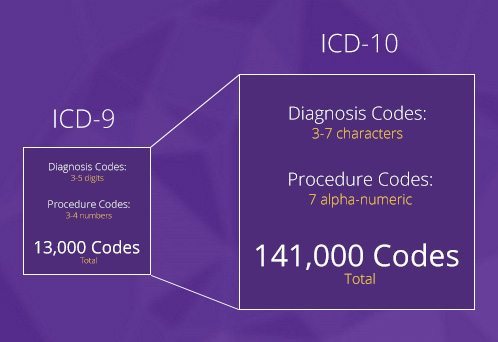Here’s Why Orthopedic ICD-10-CM Codes Still Matter

At the time of the ICD-10 transition, the previous system was more than 35 years old.1 The United States was the only industrialized nation that had not yet implemented ICD-10, and the ICD-9 system was unable to capture the scope of current medical practice. Today, ICD-10 coding accuracy remains an important aspect of running a successful orthopedic practice. These codes help capture the nuances of patient conditions. Additionally, if code selection is not supported with proper documentation, a practice might not be reimbursed properly.
According to the American Academy of Professional Coders, ICD-10-CM coding refers to the tenth edition of the International Classification of Diseases.2 This is a medical coding system designed by the World Health Organization to catalog and classify diseases and capture specific conditions. This system was designed with the intention to map the nuances of diseases to broader morbidities. Generally speaking, the ICD-10-CM code set is a diagnosis code set used across all healthcare settings.
ICD-10-CM codes are designed to provide a picture of the patient encounter, including causes of disease and complications for care.3 In addition to supporting coverage for payment by defining medical necessity, they also support statistical tracking across the care continuum. The codes also provide clues to the severity of a condition and contribute to research on outcomes.

One resource for common orthopedic ICD-10 codes can be found on CMS.com. This helpful guide lists common ICD-10 codes, along with clinical scenario case studies explaining how to reason through code selection.4 As of the 2015 transition to the ICD-10 system, Blue Cross Blue Shield created a tip sheet for its top 10 reported orthopedic conditions5 including:
- Cervicalgia : M54.2
- Osteoarthritis : M17.0 – M17.2
- Pain in shoulder : M25.511 – M25.519
- Pain in limb : M79.601 – M79.676
- Pain in hip : M25.551 – M25.559
- Pain in ankle and foot : M25.571 – M25.579
- Intervertebral disc disorders and Radiculopathy: M51.14 – M54.17
To dive deeper into the most recent nuances of medical coding, the Centers for Medicare and Medicaid Services has a resource center dedicated to 2022 updates of the ICD-10-CM code set.6
Simply put, if your ICD-10 orthopedic coding is not supported with appropriate documentation, you may not get paid what you are legally entitled to. Many orthopedic EHR systems force you to search through codes yourself. To determine how much time you might lose searching for orthopedic codes, it’s important to consider how many patients you see in a day, as well as how much time you’d have to spend searching for codes during each patient encounter.
For increased efficiency, suggested orthopedic codes should appear as you document your chart notes, though intuitive coding in orthopedic EHR systems isn’t quite as simple as it seems. Utilizing an orthopedic EHR system built by a vendor that understands the importance of ICD-10 coding could save you valuable time.
Your focus should be on treating your patients, not searching for the code you need. Finding the right orthopedic EHR system means making sure it understands the ICD-10 language while utilizing structured data to help you achieve outcome-driven progress with data-driven results.

Just as ICD-10 can be built into an EHR system, so can specialty-specific knowledge to increase efficiency and accuracy. Templates are often prevalent in EHR systems. While an orthopedic template may appear to be a good idea in theory, the results are not conducive to an efficient workflow. Templates require added time and effort, and they’re inflexible. They take precious face-to-face time away from your patient to customize. An EHR system with built-in orthopedic knowledge, an adaptive learning engine, and a touch-based approach helps eliminate the need for templates.
An orthopedic EHR system with suggested ICD-10 code functionality and free from templates could have a strong impact on increasing efficiencies for all — practice, providers and patients. ModMed’s EHR system, EMA®, is template-free.
Of course, manually searching for all orthopedic ICD-10 codes required for each scenario you face is not an efficient way to practice medicine. Luckily, there are orthopedic electronic health record (EHR) systems available to help relieve the pain of searching for the code you need using built-in suggested coding functions.
For example, EMA utilizes structured data to suggest ICD-10 codes while you’re populating your chart notes. However, it’s important to remember that EMA’s suggested codes are just that – suggestions. You always need to ensure your selected code reflects the medical documentation and that the services provided were medically reasonable and necessary before you finalize the visit.
This structured data approach uses domain knowledge of programmed diagnoses to suggest information, instead of using templates you need to customize yourself. EMA uses structured data not just to suggest codes, but also to offer various plans within the documentation, including labs, x-rays, physical therapy orders and more.
1 CMS.gov: Transitioning to ICD-10, February 25, 2015.
2 AAPC: What is ICD-10?, May 20, 2021.
3 NCBI, U.S. National Library of Medicine; Adv Wound Care: ICD-9-CM to ICD-10-CM Codes: What? Why? How?, December 2013.
4 CMS.gov: ICD-10 Clinical Concepts for Orthopedics, October 1, 2015.
5 BCBS: Musculoskeletal ICD-10-CM Coding Tip Sheet, 2014.
6 CMS.gov: 2022 ICD-10-CM, August 10, 2021.
The materials included in this blog were current as of December 16, 2021 and may be subject to change. Updates and details on the topics contained herein may be available from the CMS, the CDC, and other commercial payers. Modernizing Medicine makes no warranty regarding the ongoing accuracy of the information provided.
This blog is intended for informational purposes only and does not constitute financial, legal, medical or consulting advice. Please consult with your legal counsel and other qualified advisors to ensure compliance with applicable laws, regulations, and standards.
